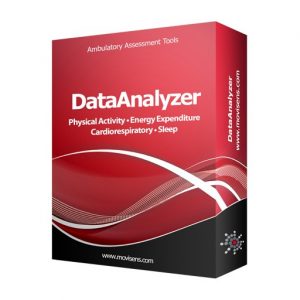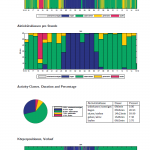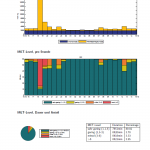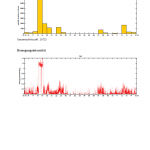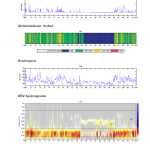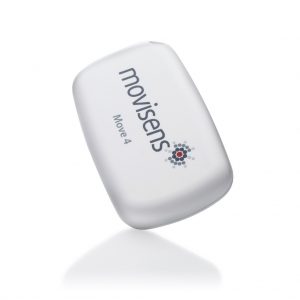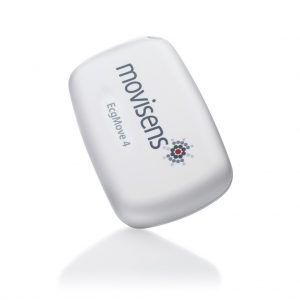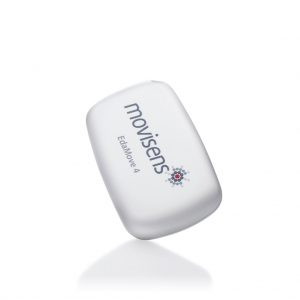DataAnalyzer – Sensor-Daten Analyse
Der movisens DataAnalyzer verarbeitet die Rohdaten des jeweiligen Sensors um in wenigen Schritten physiologische Parameter in frei wählbaren Ausgabeintervallen zu berechnen.
Der DataAnalyzer speichert die gewählten Parameter im csv-Format, sodass Forscher sich mit den Daten eingehend befassen und in Excel oder SPSS weiter verarbeiten können. Eine umfassende Übersicht und Zusammenfassung der wichtigsten Informationen, die aus den Sensordaten abgeleitet werden, stellen unsere PDF-Reports in einfach lesbaren Diagrammen und Tabellen dar.
Die Software verarbeitet die aufgezeichneten Rohdaten der Sensoren und speichert diese im unisens-Format ab. Der DataAnalyzer vervollständigt unsere Sensor-Reihe (Move 4, EcgMove 4, LightMove 4, EdaMove 4) für eine umfassende Datenauswertung. Die Software ermöglicht es außerdem, eine gesamte Studie im Batch-Process-Modus auszuwerten, wobei automatisch, basierend auf dem jeweiligen Sensor-Typ und der Trageposition, die auswählbaren Ausgabeparameter angezeigt werden.
Sowie unsere Sensoren wird auch der DataAnalyzer einmalig gekauft, ohne Erneuerungs- oder Abonnement-Gebühren! Einmal gekauft, gehört er Ihnen! Standardmäßig beinhaltet der DataAnalyzer Algorithmen, die die Berechnung von körperlichen Parametern ermöglichen, welche von unserem erstklassigen Akzelerometer gemessen werden.
Die folgenden Module können zusätzlich zum Base-Modul erworben werben:
- Energy Expenditure
- Cardio/HRV
- Electrodermal Activity/EDA
- Sleep
- Ambient Light
- Physical Activity Metrics
Top-Features
- Im Studienmodus ganze Studien automatisch mit einem Click auswerten
- Freie Wahl der Ausgabeparameter
- Einstellbare Ausgabeintervalle
- Ausgabe optimiert für Weiterverarbeitung (Excel, SPSS)
- Integrierter Generator für aussagekräftige Berichte (PDF)
Anwendungen
- Auswertung von Aktivitäts-, EKG- und EDA-Messdaten
- Aktivitätserkennung und Energieumsatzschätzung
- Herzrate und Herzratenvariabilität
- Elektrodermale Aktivität
- Untersuchung des vegetativen Nervensystems (autonomen Nervensystems ANS)
- Verhaltensmonitoring
- Psycho-physiologisches Belastungs-Monitoring
Dazu passende Produkte und Leistungen
Beschreibung der Module
Mit dem Aktivitätserkennungs-Modul können Sie die Aktivitätsdaten der Sensoren Move 4, LightMove 4, EcgMove 4 sowie EdaMove 4 auswerten. Folgende Parameter sind verfügbar:
- Körperpositionen
- Beschleunigung in Richtung der Körperachsen
- Schritte
- Aktivitätsklassen: Liegen, Ruhe, Gehen (inkl. Steigungen), Joggen
- Neigungswinkel der Körperachsen
- Höhe
- Vertikalgeschwindigkeit
- Berichte zur körperlichen Aktivität (PDF)

Mit dem Energieumsatzbestimmungs-Modul können Sie die Aktivitätsdaten der Sensoren Move 4 und EcgMove 4 hinsichtlich des Energieumsatzes auswerten:
- Aktivitätsenergieumsatz
- Gesamtenergieumsatz
- Metabolische Äquivalente / MET
- Übersicht Energieumsatz
- Bericht zur körperlichen Aktivität und zum Energieumsatz (PDF)

Mit dem Cardio/HRV-Modul können Sie die EKG-Daten des Sensors EcgMove 4 auswerten:
- EKG R-Zacken
- Normalschläge und Intervalle
- Schlag für Schlag Herzrate
- Herzrate
- HRV Parameter Low Frequency (LF)
- HRV Parameter High Frequency (HF)
- HRV Parameter Verhältnis Low zu High Frequency (LF/HF)
- HRV Parameter SDNN
- HRV Parameter RMSSD
- HRV Parameter SD1
- HRV Parameter SD2
- HRV Parameter SD2/SD1
- Bericht zur Herzratenvariabilität (PDF)

Mit dem Elektrodermale Aktivität-Modul können Sie die EDA-Daten des Sensors EdaMove 4 auswerten:
- Skin conductance level SCL
- SCR Amplituden
- SCR Anstiegszeiten
- SCR Energie
- SCR half recovery times
- Anzahl der SCR
- Mittlere SCR Amplitude
- Mittlere SCR Abstiegszeiten
- Mittlere SCR Energie
- Mittlere SCR half recovery times
- Elektrodermale Aktivität als Text-Datei zur Weiterverarbeitung in externer Software

Mit dem Sleep-Modul können Sie die Daten der Sensoren Move 4, LightMove 4, EcgMove 4 sowie EdaMove 4, Move 3, LightMove 3, EcgMove 3 sowie EdaMove 3 auswerten. Folgende Parameter sind verfügbar:
- Sleep/wake detection
- Lights out detection

Mit dem Ambient Light-Modul können Sie die Daten des Sensors LightMove 4 auswerten. Folgende Parameter sind verfügbar:
- Illumination
- Color Temperature
- Light Situation detection

Mit dem Physical Activity Metrics-Modul können Sie die Beschleunigungs-Daten aller movisens Sensoren auswerten und die üblichen Physical Activity Metriken berechnen. Physical Activity Metrics sind Algorithmen welche aus den aufgenommenen Rohdaten des Beschleunigungssensors Werte berechnen, die mit der Intensität der körperlichen Aktivität einer Person korrelieren. Folgende Parameter sind verfügbar:
- Euclidian Norm (EN)
- Eucldian Norm Minus One (ENMO)
- HFEN, BFEN, HFEN+
- Zero Crossing
- Proportional Integrating Measure (PIM)
- Mean Amplitude DeviationMean (MAD)
- ActiWatch 4 counts

Downloads
| Newsletter |
|
|---|---|
| Software |
|
| Dokumentation |
|
| Beispieldaten |
|
| Beispielberichte | |
| Externe Tools |
Systemvoraussetzungen
Foglende Systemvoraussetzungen müssen erfüllt werden:
- PC mit Microsoft Windows 7 oder neuer, 64bit
- Microsoft Excel für Reports im Excel-Format
- Administratorrechte während der Installation
- Mindestens 2.1GB freier Speicher
Änderungshistorie
- Bugfix: Make sure that the parameter threeHipPositions is taken into consideration when generating report.
- Add new output parameter called paMetricActigraphCountsVectorMagnitude, that computes the vector magnitude of ActiGraph counts, averaged over the output interval.
- Expand the possibilities of physical activity metrics to choose from for the calculation of Activity Level (ActivityLevelFromPaMetric).
- Bugfix: output parameters paMetricActigraphCountsActiLifeDown, paMetricActigraphCountsActiLifeForward, paMetricActigraphCountsActiLifeRight are now shown in Results.xlsx file.
- Correct any missing explanations for output parameters.
- Implement the ActiLife Algorithm from https://github.com/actigraph/agcounts.git to calculate the ActiGraph counts.
- Add additional output parameters for DataAnalyzer: PaMetricActigraphCountsActiLifeDown, PaMetricActigraphCountsActiLifeForward, PaMetricActigraphCountsActiLifeRight.
- Bugfix for altitude calculation: Ensure that indices are always positive.
- Changes affect the output parameter NonWearSleepWake. They improve the detection of extended periods when sensor is not worn.
- Bugfix in activity pdf reports (ReportActivity.pdf and ReportActivityEe.pdf). The 'total' parameter in activity class table shows now the full day as 24 hours.
- Make alignment at midnight optional for output parameters ReportActivityEeSummary.xlsx and ReportActivitySummary.xlsx.
- Add new column to Results.xlsx table that documents the markers set in signal marker.csv.
- Bugfix in activity excel reports (ReportActivityEeSummary.xlsx and ReportActivitySummary.xlsx). The parameter "Average of full days" now shows the last day as a full day when the recoding of the last day is exactly 24 hours.
- Bugfix in plot energy expenditure summary.
- New Parameter: ActivityLevelFromPaMetric
- Bugfix: Check minimal amount of data needed for Step Count Summary.
- Bugfix in function listing available activity classes for reports.
- Make additional outputs visible for DataAnalyzer: BeatDropReason, EcgValidSeg, HrvIsValid, HrIsValid.
- Output ReportSleepPdf even when body position is not calculable.
- Separate light activity level time into not active level time and light level time in ReportActivityEESummaryExcel.
- Calculate reports when the parameter threeHipPositions is set to true.
- Set ColorTemperature to -1 if cannot be calculated.
- Add additional outputs HrvIsValid and HrIsValid
- Activated PaMetrics in Test License
- Optimized license code parser
- Fix error in CalcReportSleep
- Make body positions optional for ReportSleepPdf
- Change reportSleep name to reportSleepPdf
- Add description for reportSleep
- Set colorTemperature to -1 if it is not calculable
- Fixed bug in ReportActivityEeSummaryExcel by separating light activity level time into not active level time and light level time
- Fix Bug in HRV Segmentation, Welch algorithm for small windows
- For non wear detection output enum nonWear always when sensor is charging
- Add new report for sleep
- Add movement acceleration information for reports ActivitySummaryExcel and ActivityEeSummaryExcel
- Add reports ActivitySummaryPdf and ActivitySummaryShortPdf for sensor location ankle, upper arm and thigh without EE and Met plots
- Improve Altitude Filtering
- PaMetricPim: Allow calculation of PaMetricPim with all acceleration signal sample rates (other than 64Hz)
- PaMetricAiAbs: remove noise floor according to sensor type
- Add MovementAcceleration to ReportActivitySummaryExcel and ReportActivityEeSummaryExcel
- Bug fix in wear detection
- Enable ReportActivitySummaryPdf and ReportActivitySummaryShortPdf for sensor location ankle
- Bugfix: DataAnalyzerCmd now considers option targetPath
- Bugfix: ReportActivityPdf now works for sensor location ankle
- Bugfix: Added missing translations for measurement parameters in GUI
- Bugfix: Correct calculation of absolute date/time after more than ~24days in Results.xlsx
- Bugfix: Correct unit for EdaScrHalfRecoveryTimes
- Show metEpoch length in ReportEeSummaryExcel
- Added new module for physical activity metrics
- Add cycling detection
- Add functions to generate 3 body positions for sensor location hip
- Added new output parameter for sedentariness
- Add body position calculation for ankle
- Improve bodyposition calculation
- Bugfix: Allow summary reports longer than 9 days
- Bugfix: Custom algorithm configurations now work for DataAnalyzerCmd
- Bugfix: Korrekte Ausgabe der Results.xlsx Excel-Dateien bei leeren SignalEntries am Ende der Messung
- Unterstützung von kundenspezifischen Algorithmenkonfigurationen
- Parameter für HRV Frequenzbänder hinzugefügt
- Fehlende Übersetzungen in Fusszeilen hinzugefügt
- Plausibilitätscheck von MET Werten verbessert
- Übersetzungen im StepCount Summary Plot
- Fehlende Sensorpositione left_side_hip für Move II hinzugefügt
- Neuer Excel Summary Report ohne Ee Daten im Base Modul
- Berücksichtigung von manuell markierten Artefakten im EKG
- Unterstützung für 4. Sensor Generation hinzugefügt
- Bugfix im Parameter CalcLightsOut
- Bugfix im Parameter ReportTableHrvAndActivity
- Bugfix im Baevsky Stress Index Algorithmus für sehr kleine Variabilitäten
- Bugfix: ReportHrvPdf für alle Tage der Messung erstellen
- Bugfix: Baevsky Stress Index korrekt berechnen bei kleinen Variabilitäten
- Unterstützung für 4k Displays
- Bugfix: Berechnung stoppen wenn Dialog geschlossen wird
- Bugfix: Löschen von Zielordner verhindern (Pfad nicht editierbar)
- Bugfix: Im Batch-Modus Attribute (age, gender, etc.) aus Messung laden
- Neues Modul Sleep mit schlaf/wach Detektion hinzugefügt
- Unterstützung für Umgebungslichtsensor LightMove 3 hinzugefügt
- Neue Algorithmen für Umgebungslicht: Beleuchtungsstärke(illuminance), Farbtemperatur (color temperature), Licht-aus-Detektion (lights out detection)
- ECG RR-filter verbessert
- Ablageerkennung (non wear detection) verbessert
- Neuer Ausgabeparameter: EDA SCL
- Parameter Ablageerkennung, MVPA, MVPA bouts zum Übersichts-Bericht hinzugefügt
- Unterstützung für unisens-CSV format
- Verbesserung das Farbkonzept in Berichten
- Besserer Bericht für MET level
- Bessere Darstellung von Tabelle in Berichten
- Bessere Unterstützung für weitere Sensor-Tragepositionen in Berichten
- Bessere Erkennung von Körperpositionen für Trageort Oberschenkel
- Bugfix für fehlende Werte am Ende von der Results.xslx Datei
- Neue PDF Berichte
- Unterstützung für weitere Sensoren und Sensortragepositionen
- Neuer Berichtsgenerator für PDF Berichte
- Anlageerkennung hinzugefügt
- Verbesserte Filterung von RR-Intervallen
- Verbesserter HRV-Parameter RMSSD
- Neue Algorithmen Licht-Sensor (Beleuchtungssstärke und Farbtemperatur)
- LaTeX und Excel entfallen als Systemvoraussetzung
- Verbesserung der RR-Filterung
- Verbesserung der Berechnung der spektralen HRV Parameter
- Verbesserte Berechnung von AEE, TEE und MET durch Nutzung zusätzlicher Modelle für Steigungen
- Bugfixes in PDF Berichten
- Unterstützung neuer Sensoren
- Verbesserte EDA SCR-Erkennung
- Fehlender Parameter EdaScl hinzugefügt (Skin Conductance Level)
- Neuer Parameter Atemfrequenz aus dem EKG (ECG derived respiration EDR)
- Anwendung des Ausgabeintervalls beim Parameter EdaArousal
- Unterscheidung von Stehen und Sitzen (Sensorposition Oberschenkel)
- Temperaturparameter hinzugefügt
- HRV Parameter pNN50 hinzugefügt
- Ausgabe aller gewählten Parameter in einer Excel Tabelle inklusive übersichtlicher Spaltenbeschreibung (Results.xslx)
- Neues Modul für Cardio/HRV mit vielen HRV Parametern, Baevsky-Stress-Index und neuem HRV-Bericht als PDF
- Neues Modul für EDA mit allen relevanten EDA-Parameter und einem neuen Arousal-Parameter
- Alle PDF-Berichte wurden überarbeitet und sind jetzt auch in Deutsch und Englisch verfügbar
- Neuer PDF-Übersichtsbericht für körperliche Aktivität
- Verbesserung der Erkennung von Körperpositionen
- Verbesserung der Energieumsatzschätzung bei Ruhe/Sitzen
- Verbesserung von Plots und Layout in den PDF-Berichten
Literatur und Validierung
- Predicting the onset of psychotic experiences in daily life with the use of ambulatory sensor data – A proof-of-concept study.
- Impact of a Semi-Rigid Knee Orthotic Intervention on Pain, Physical Activity, and Functional Capacity in Patients with Medial Knee Osteoarthritis.
- Exploring the Link between Lifestyle, Inflammation, and Insulin Resistance through an Improved Healthy Living Index.
- Acute Fasting Modulates Autonomic Nervous System Function and Ambulatory Cardiac Interoception.
- Determination of cut-off points for the Move4 accelerometer in children aged 8–13 years.
- The cardiac correlates of feeling safe in everyday life: A Bayesian replication study.
- Spontaneous infant crying modulates vagal activity in real time.
- Human uncertainty in interaction with a machine: establishing a reference dataset.
- Momentary within-subject associations of affective states and physical behavior are moderated by weather conditions in real life: an ambulatory assessment study.
- Rethinking Learning Experience: How Generally Perceived Life Stress Influences Students’ Course Perceptions in Different Learning Environments.
- Microtemporal Dynamics of Dietary Intake, Physical Activity, and Impulsivity in Adult Attention-Deficit/Hyperactivity Disorder: Ecological Momentary Assessment Study Within Nutritional Psychiatry.
- Ecological Momentary Assessment in Nutritional Psychiatry: Microtemporal Dynamics of Dietary Intake, Physical Activity, and Impulsivity in Adult ADHD.
- The Work Lifestyle-integrated Functional Exercise Program for Preventing Functional Decline in Employees over 55 years: Development and Initial Evaluation.
- Off-the-shelf wearable sensing devices for personalized thermal comfort models: A systematic review on their use in scientific research.
- Does Being Ignored on WhatsApp Hurt? A Pilot Study on the Effect of a Newly Developed Ostracism Task for Adolescents.
- Interactive teaching enhances students' physiological arousal during online learning.
- Tranquillity, transcendence, and retreat: the transformative practice of listening at Evensong.
- Momentary feelings of safety are associated with attenuated cardiac activity in daily life: Preliminary evidence from an ecological momentary assessment study.
- Flow bei der Arbeit greifbar machen.
- Measuring catatonia motor behavior with objective instrumentation.
- Mood-enhancing Physical Activity in Individuals with Attention-Deficit/Hyperactivity Disorder (ADHD) and Healthy Youths – Daily Life Investigations by Ambulatory Assessment.
- Decreased sympathetic cardiovascular influences and hormone-physiological changes in response to Covid-19-related adaptations under different learning environments.
- Deepaware: A hybrid deep learning and context-aware heuristics-based model for atrial fibrillation detection.
- The association of stress and physical activity: Mind the ecological fallacy.
- Combining cardiac monitoring with actigraphy aids nocturnal arousal detection during ambulatory sleep assessment in insomnia.
- The dynamical association between physical activity and affect in the daily life of individuals with ADHD.
- How does it feel to walk in Berlin? Designing an Urban Sensing Lab to explore walking emotions through EDA sensing.
- Assessing New Methods to Optimally Detect Episodes of Non-metabolic Heart Rate Variability Reduction as an Indicator of Psychological Stress in Everyday Life: A Thorough Evaluation of Six Methods.
- Effects of exercise training on heart rate variability in children and adolescents with pulmonary arterial hypertension: a pilot study.
- Effects of Biophilic Interventions in Office on Stress Reaction and Cognitive Function: A Randomized Crossover Study in Virtual Reality.
- Dynamics of Intraindividual Variability in Everyday Life Affect Across
Adulthood and Old Age. - Neural correlates of individual differences in affective benefit of real-life urban green space exposure.
- Sedentary behavior in everyday life relates negatively to mood: An ambulatory Assessment study.
- Brute Force ECG Feature Extraction Applied on Discomfort Detection.
- An experience sampling study on the nature of the interaction between traumatic experiences, negative affect in everyday life, and threat beliefs.
- Immediate and sustained effects of intermittent exercise on inhibitory control and task-related heart rate variability in adolescents.
- Transcutaneous vagus nerve stimulation and emotional inhibition of return.
- A mixed-methods study of physiological reactivity to domain-specific problem solving: methodological perspectives for process-accompanying research in VET.
- Does a 20-week aerobic exercise training programme increase our capabilities to buffer real-life stressors? A randomized, controlled trial using ambulatory assessment.
- Home-based system for physical activity monitoring in patients with multiple sclerosis (Pilot study).
- Using Support Vector Regression for Assessing Human Energy Expenditure Using a Triaxial Accelerometer and a Barometer.
- Classification of Human Physical Activity and Energy Expenditure Estimation by Accelerometry and Barometry.
- A new method to estimate energy expenditure using accelerometry and barometry-based energy models.
- Validity of the kmsMove-sensor in calculating energy expenditure during different walking intensities.
- Estimation of energy expenditure using accelerometers and activity-based energy models - validation of a new device.
- Energieumsatzmessung mit Aktivitätssensoren – Validität des kmsMove-Akzelerometers.
- Heart rate variability: standards of measurement, physiological interpretation and clinical use. Task Force of the European Society of Cardiology and the North American Society of Pacing and Electrophysiology..
